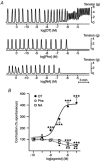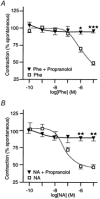Catecholamines are not linked to myometrial phospholipase C and uterine contraction in late pregnant and parturient mouse
- PMID: 11579162
- PMCID: PMC2278844
- DOI: 10.1111/j.1469-7793.2001.00123.x
Catecholamines are not linked to myometrial phospholipase C and uterine contraction in late pregnant and parturient mouse
Abstract
1. We investigated whether catecholamines through activation of alpha(1)-adrenergic receptors (alpha(1)-AR) are involved in mouse uterine contraction at parturition. Myometrial phospholipase C (PLC) activity and uterine contraction were measured in response to noradrenaline (NA), the specific alpha(1)-AR agonist phenylephrine (Phe) and oxytocin (OT). 2. Using the reverse transcription-polymerase chain reaction RT-PCR, we detected the alpha(1a)-AR subtype in late pregnant mouse myometrium. We also detected, by immunoblotting studies, PLCbeta(1), PLCbeta(3) and different alpha-subunits of pertussis toxin-insensitive (Galpha(q/11)) and -sensitive G proteins (Galpha(o/i3), Galpha(i1/2)). 3. Phenylephrine and NA did not alter the myometrial inositol phosphate (InsP) production of late pregnant or parturient mouse. In similar conditions, OT increased InsP production in a dose-dependent manner. Consistent with these results, only OT (10 microM) recruited PLCbeta(1) and PLCbeta(3) to myometrial plasma membranes. The OT-induced InsP response was not altered by pertussis toxin (300 ng ml(-1), 2 h pretreatment), suggesting the involvement of a member of the Galpha(q) family. 4. Noradrenaline and Phe failed to increase uterine contraction at late pregnancy and at parturition. In contrast, OT induced uterine contraction in a dose-dependent manner with maximal increase (400 %) at a concentration of 1 microM. 5. The results indicate that OT receptors (OTR) but not alpha(1)-AR are linked to myometrial PLC activation and uterine contraction in late pregnant and parturient mouse. This discrepancy between mouse and other mammals could be attributed to the alpha(1)-AR subtype expressed in myometrium at this time.
Figures






Similar articles
-
Increased potency of alpha 1-adrenergic receptors to induce inositol phosphates production correlates with the up-regulation of alpha 1d/Gh alpha/phospholipase C delta 1 signaling pathway in term rat myometrium.Reproduction. 2008 Jan;135(1):55-62. doi: 10.1530/REP-07-0332. Reproduction. 2008. PMID: 18159083
-
Regulation of myometrial phospholipase C system and uterine contraction by beta-adrenergic receptors in midpregnant rat.Biol Reprod. 2004 Mar;70(3):570-6. doi: 10.1095/biolreprod.103.021535. Epub 2003 Oct 29. Biol Reprod. 2004. PMID: 14585815
-
Up-regulation of rat myometrial phospholipases C{beta}1 and C{beta}3 correlates with increased term sensitivity to carbachol and oxytocin.J Endocrinol. 2005 Nov;187(2):197-204. doi: 10.1677/joe.1.06388. J Endocrinol. 2005. PMID: 16293767
-
Parturition: activation of stimulatory pathways or loss of uterine quiescence?Adv Exp Med Biol. 1995;395:435-51. Adv Exp Med Biol. 1995. PMID: 8713997 Review.
-
Oxytocin and parturition: a role for increased myometrial calcium and calcium sensitization?Front Biosci. 2007 Jan 1;12:619-33. doi: 10.2741/2087. Front Biosci. 2007. PMID: 17127323 Review.
Cited by
-
Inhibition of monoamine oxidases desensitizes 5-HT1A autoreceptors and allows nicotine to induce a neurochemical and behavioral sensitization.J Neurosci. 2009 Jan 28;29(4):987-97. doi: 10.1523/JNEUROSCI.3315-08.2009. J Neurosci. 2009. PMID: 19176807 Free PMC article.
References
-
- Alexandrova M, Soloff Ms. Oxytocin receptors and parturition. Concentrations of receptors for oxytocin and estrogen in the gravid and nongravid uterus at term. Endocrinology. 1980;106:736–738. - PubMed
-
- Bradford MM. A rapid and sensitive method for the quantitation of microgram quantities of protein utilizing the principle of protein-dye binding. Anaytical Biochemistry. 1976;72:248–254. - PubMed
-
- Breuiller-Fouche M, Doualla-Bell Kotto, Maka F, Geny B, Ferre F. Alpha-1 adrenergic receptor: binding and phosphoinositide breakdown in human myometrium. Journal of Pharmacology and Experimental Therapeutics. 1991;258:82–87. - PubMed
-
- Cavalli A, Lattion A-L, Hummler E, Nenniger M, Pedrazzini T, Aubert J-F, Michel MC, Yang M, Lembo G, Vecchione C, Mostardini M, Schmidt A, Beerman F, Cotecchia S. Decreased blood pressure response in mice deficient of the α1b-adrenergic receptor. Proceedings of the National Academy of the Sciences of the USA. 1997;89:9544–9548. - PMC - PubMed
-
- Cohen-Tannoudji J, Mhaouty S, Elwardy-Merezak J, Lecrivain JL, Robin MT, Legrand C, Maltier JP. Regulation of myometrial Gi2, Gi3, and Gq expression during pregnancy. Effects of progesterone and estradiol. Biology of Reproduction. 1995;53:55–64. - PubMed
MeSH terms
Substances
LinkOut - more resources
Full Text Sources
Research Materials

